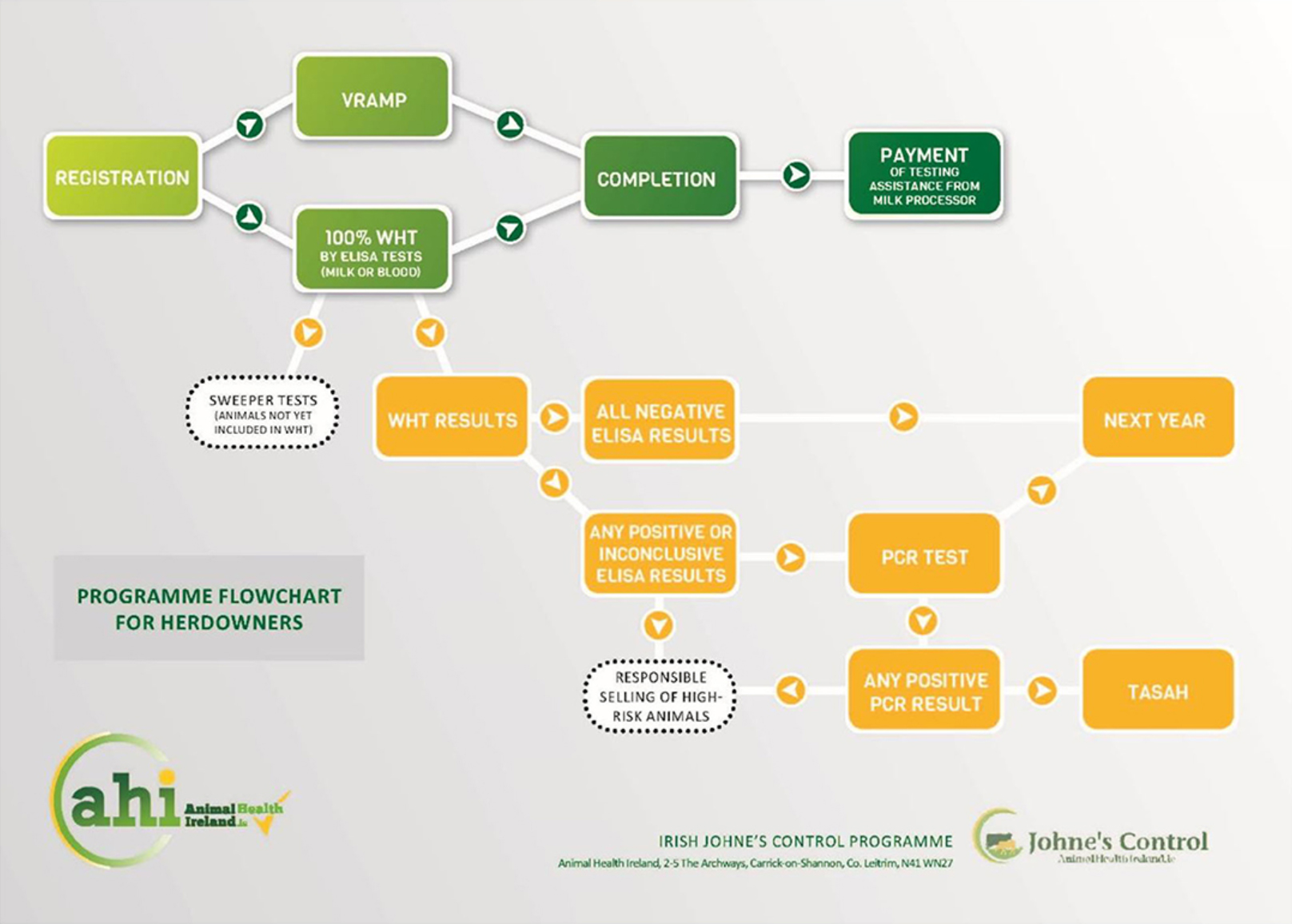Lawrence Gavey and colleagues from Animal Health Ireland and the Centre for Veterinary Epidemiology and Risk Analysis, UCD School of Veterinary Medicine, University College Dublin published an article describing the Irish Johne’s disease (JD) control program. Their Open Access article appeared August 27, 2021, in the journal Frontiers in Veterinary Science.
ABSTRACT
The Irish Johne’s Control Programme (IJCP) provides a long-term approach to the voluntary control of Johne’s disease (JD) in Ireland, strongly supported by Irish cattle industry leadership. It leverages the establishment of Animal Health Ireland for control of animal diseases not regulated by the European Union. The IJCP has four objectives: facilitate protection against spread of JD to uninfected farms; reduce the level of infection when present; assure markets of JD control in Ireland; and improve calf health and farm biosecurity. Key IJCP elements are an annual veterinary risk assessment and management plan (VRAMP), annual whole herd test (WHT) by ELISA on blood or milk samples with ancillary faecal PCR testing of ELISA reactors, and Targeted Advisory Service on Animal Health (TASAH) investigations of infected herds. There are pathways for assurance of herds with continuing negative tests and for management of test-positive herds. Herdowners are responsible for on-farm activities, and specifically-trained (approved) veterinary practitioners have a pivotal role as technical advisors and service providers. The programme is supported by training of veterinarians, performance of testing in designated laboratories, documentation of policies and procedures, innovative data management for herd and test activities and for programme administration, training, and broad communication and awareness activities. Tools and systems are refined to address emerging issues and enhance the value of the programme. An Implementation Group comprising industry, government and technical leaders sets strategic direction and policy, advised by a Technical Working Group. Shared funding responsibilities are agreed by key stakeholders until 2022 to support herds in the programme to complete requirements. Herd registrations have increased steadily to exceed 1,800. National bulk tank milk surveillance is also being deployed to identify and recruit test-positive herds with the expectation that they have a relatively high proportion of seropositive animals. The programme will continue to innovate and improve to meet farmer and industry needs.

Website editor’s note: According to the Irish Cooperative Organisation Society’s website, “There are 18,000 dairy farmers in Ireland, producing milk of an outstanding quality from over 1.2 million dairy cows. Irish dairy farms are family run enterprises, supplying 6.4 billion litres of milk in 2015.” This means that the Irish Johne’s Control Programme has enrolled roughly 10% of Irish dairy herds this far.

COMMENT
The Irish JD program has all the same elements found in most national Johne’s disease programs:
1. Education of producers and veterinarians.
2. Herd risk assessments to identify when and where MAP transmission occurs on the farm.
3. Changes to animal husbandry methods to limit MAP transmission.
4. Regular application of diagnostic tests to all adults in the herd for many years.
5. Consistent actions based on the diagnostic test results.
6. Monitoring progress.
The program is also available for beef cattle producers.
The authors of this publication discuss the challenges for sustaining and growing the program stating: “The judgement of insufficient reward for the risk, inconvenience and expense of participation, especially for low-risk herds, remains a constant limitation and is recognised as an inhibitor to uptake of programmes internationally”.
This impediment could be addressed by paying farmers more for milk from herds that are test-negative or deemed to be low-risk. Currently, according to the Animal Health Ireland (AHI) website, Irish milk processors pay dairy farmers a set amount per cow each year depending on whether they are in the test-negative pathway or the test-positive pathway and the number of years in the program, as shown below (copied from the AHI website).
Funding Support per Eligible Animal by Year of Registration
Test-negative pathway
- €2.75 ($3.25)**
- €2.06 ($2.43)
- €1.38 ($1.63)
- Nil*
Test-positive pathway
- €2.75 ($3.25)
- €2.75 ($3.25)
- €2.75 ($3.25)
- €2.75 ($3.25)
*It is anticipated that after four consecutive years of test-negative results, herds in the text-negative pathway will move to a lower-intensity maintenance testing programme – details of which are to be announced in the near future.
** Currency conversion based on values on 11-SEP-2021.
There are two problems with this. First, while I am sure the financial support is welcome, it represents a very small portion of the actual costs that dairy producers incur when trying to control JD. For more on the costs of a JD control program see Table 6 in Roch, et al. Journal of Dairy Science, 2020 (Open Access).
Secondly, in this plan for test-negative herds there appears to be a financial disincentive to remain in the program. It seems to me that test-negative herds should be paid an increasing amount for each year they remain in the program and the test-positive herds that do not show progress in the program after 3 years should have a decreasing rate of financial support. Farmers must spend money not only on annual diagnostic testing of their herd but also the management changes necessary to limit MAP transmission. They do this for the health and welfare of their animals but also for the health and safety of the public and the profitability of the Irish dairy industry as a whole.

In 2019, according to the Irish Dairy Board website, Irish dairy exports reached €4.4 billion, making it the largest food and drink export category. This was the third consecutive year in which the value of dairy exports exceeded the €4bn mark. Protection and expansion of export markets are a major driver for the Irish dairy industry as the graphic below shows.
Profits from the export of dairy products, that rely on the eco-friendly, wholesome and healthy image of Irish dairy products with a zero or very low MAP infection rate, need to be equitably shared with the people who make this possible, the Irish dairy producers.